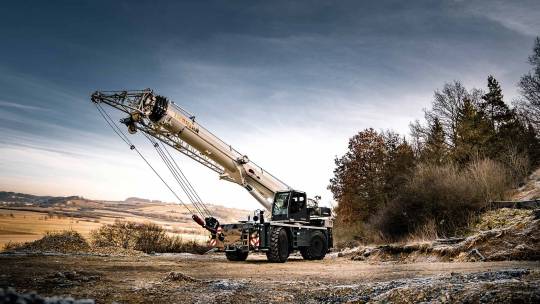#TelematicsInConstruction
Explore tagged Tumblr posts
Text
Rough Terrain Crane Market Drivers Include Infrastructure Expansion and Off-Road Construction Needs
Infrastructure development initiatives across both developed and emerging economies are fueling the demand for robust, versatile lifting machinery. The Rough Terrain Crane Market is experiencing notable growth, largely driven by the pressing need for efficient equipment that can navigate off-road job sites and support large-scale construction efforts in remote or rugged areas.

Expanding Infrastructure Projects Fueling Market Demand
The surge in infrastructure spending, particularly in roads, bridges, airports, and urban transport corridors, is a primary driver for rough terrain crane deployment. Governments and private players are investing heavily in megaprojects that demand flexible, mobile cranes capable of traversing undeveloped sites. For example, India’s National Infrastructure Pipeline and the U.S. Infrastructure Investment and Jobs Act have allocated massive capital toward civil and industrial infrastructure, creating strong tailwinds for crane manufacturers.
Off-Road Construction Needs Boost Equipment Versatility
Unlike tower or truck-mounted cranes, rough terrain cranes are specifically designed for off-highway construction sites where uneven surfaces, mud, and obstacles pose operational challenges. These cranes feature all-wheel drive, compact chassis, and advanced suspension systems, making them indispensable in oil fields, dam construction, and mountainous projects. Their all-terrain mobility gives them a competitive edge in geographies with poor access roads or underdeveloped infrastructure.
Urbanization and Industrialization Accelerating Uptake
The global trend toward rapid urbanization, especially in Asia-Pacific, Africa, and Latin America, is another powerful market stimulant. With cities expanding outward and upward, there is a growing need for construction equipment that can perform reliably in variable terrain. Moreover, industrialization in these regions is resulting in the development of logistics parks, manufacturing hubs, and energy facilities—all requiring reliable lifting solutions in challenging work conditions.
Public-Private Partnerships and Government Support
Public-private partnerships (PPPs) have emerged as critical tools in unlocking large-scale infrastructure financing. These cooperative frameworks often involve long-term construction timelines in varying terrains, further increasing reliance on rough terrain cranes. In addition, regulatory push for faster project delivery—especially in transportation, energy, and water infrastructure—is prompting contractors to adopt equipment that ensures speed, safety, and efficiency.
Technological Integration Enhancing Performance
Market drivers also include the adoption of smart features that improve crane operability and maintenance. Leading manufacturers are incorporating telematics, remote diagnostics, and load-moment indicators, which not only enhance performance but also reduce downtime and improve job site safety. These technological upgrades make rough terrain cranes even more appealing to contractors managing complex infrastructure developments.
Regional Expansion Opportunities
Asia-Pacific holds a dominant share of the global market, driven by infrastructure-heavy economies like China, India, and Indonesia. Meanwhile, Africa and Latin America are emerging as high-growth regions, thanks to rising demand for energy infrastructure, mining, and port development. In North America and Europe, replacement cycles and upgrades in aging construction fleets are creating a stable demand base.
Challenges and Considerations
Despite strong growth indicators, certain constraints exist. High initial procurement costs and the need for skilled operators remain barriers, especially for smaller construction firms. However, rental models are mitigating these factors, allowing broader access to advanced crane technology without the capital burden of ownership.
Competitive Landscape
Leading players in the market—such as Tadano, Terex Corporation, Liebherr, and Zoomlion—are investing in R&D to deliver more fuel-efficient and terrain-adaptable models. These firms are also expanding their dealer networks and after-sales service infrastructure to gain competitive advantage in newly developing regions.
Conclusion: Preparing for the Next Wave
As infrastructure projects continue to diversify in scope and scale, the Rough Terrain Crane Market is expected to see sustained momentum. Manufacturers and contractors alike are aligning their strategies to meet the rising demand for machines that can function seamlessly across multiple terrains.
#RoughTerrainCranes#InfrastructureDevelopment#ConstructionEquipment#HeavyLiftingSolutions#Urbanization#OffRoadMachinery#CraneTechnology#SmartConstruction#MobilityEquipment#IndustrialGrowth#TelematicsInConstruction
0 notes